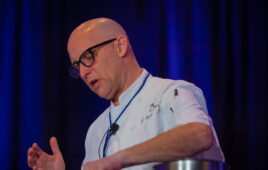Hudson Riehle, senior vice president for the National Restaurant Association’s research and information services division, told attendees of the Women’s Foodservice Forum convention in Dallas that menu prices that vary at different times of day or on days of the week offer foodservice operators an opportunity to draw new traffic during off-peak times.
At the Women’s Foodservice Forum (WFF) convention in Dallas, attendees learned that menu prices that vary at different times of day or on different days of the week offer restaurant operators an opportunity to grab new traffic in their restaurants, the Nation’s Restaurant News reported.
“Yield management” is on the cusp of making headway in the restaurant industry, according to Hudson Riehle, senior vice president for the National Restaurant Association’s research and information services division. “The hotel and airline industries have become very adept at this,” Riehle told the executives. “But when you look at what will drive consumers to use restaurants more, 72 percent report that they’d dine out more often if menu prices were lower during off-peak times.”
Technology has made great advances in the past 10 years and is now in place to tackle yield management, Riehle said, and variable menu pricing to drive more traffic in off-peak hours, the News reported.
“If you think about video menu boards in quick service or tablets in table-service restaurants, the technological capability there is to alter pricing by time of day, day of week or even season of the year,” Riehle said. “So there are operators already experimenting with this, and this will become more important going forward.”
Consumers, especially the younger ones, are primed to accept more technology in their restaurants, Riehle added. For those consumers 44 and younger, he said, “their basic expectation of a restaurant now is that it incorporates some aspect of technology.”
While yield management is what Riehle called “a fairly sophisticated management science,” he pointed out that other industries have mastered it. “And, inevitably, it is coming to the restaurant industry,” he said. “Going forward, this will be a very important developer of additional incremental demand,” the News reported.
And developing that demand is crucial, Riehle said. This year, the NRA forecasted $683 billion in sales, a 3.6-percent increase from 2013. It’s the fifth consecutive year of positive sales growth, but it is moderating. However, Riehle noted that even the moderate growth is massive compared to other industries, the News reported.
In 2013, real disposable personal income gained at just 0.8 percent. “That is quite an anemic rate,” he said. Despite that, the United States has nearly 1 million restaurants, and that number is expected to increase by 10,000 this year. That figure includes 60,000 new units and the closure of 50,000. “The churn does remain fairly substantial,” Riehle said.
“Consumer confidence remains fairly fragile and not at levels we would want to see,” Riehle explained. “In terms of their spending, consumers remain deliberative, not only in their decision to spend in the industry, but also whether to spend that dollar in foodservice or some other expenditure.”
Two out of every five consumers surveyed by the NRA said they were not using restaurants as much they would like in their daily lifestyle, and the number was highest among those consumers with household incomes of $75,000 or more, the News reported.
One area where Riehle predicted restaurants would be increasing check and luring more consumers is in quick-service adoption of alcohol beverage sales, the News reported.
“That will become a more important part of the quick-service segment going forward,” Riehle said. “There are a host of issues associated with this, in terms of labor, but what you will see with moderate growth are more quick-service establishments looking at utilizing alcoholic beverages to develop a loyal cadre.”


